星盘
星盘(英語:,希臘語:)[1] 是古代天文学家、占星师和航海家用来进行天文测量的一项重要的天文仪器,用途非常广泛,包括定位和预测太阳、月亮、金星、火星相关天体在宇宙中的位置,确定本地时间和经纬度,三角测距等。
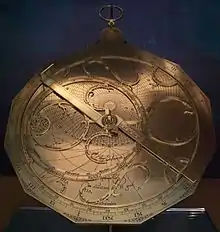
星盘
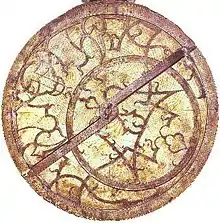
一个16世纪的简单星盘
历史
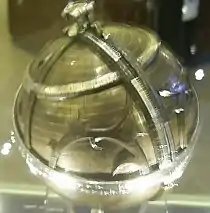
中世纪在伊斯兰出现的球型星盘
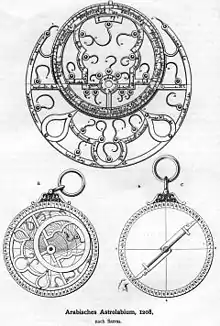
一个1208年的波斯星盘
中国的星盘
用於中國的星盤,跟西方不一樣的地方是中國使用的是12個時辰,分別是子時、丑時、寅時、卯時、辰時、巳時、午時、未時、申時、酉時、戌時、亥時,依照上面的順序排版。�{來源請求}
发展

公元1200三名卡斯蒂利亚学者正在研究星盘
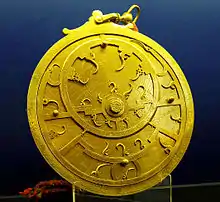
18世紀的波斯天文星盘
注釋
- "astrolabe", Oxford English Dictionary 2nd ed. 1989
- Evans (1998:155) "星盘实际上是古希腊的一项发明。"
Krebs & Krebs (2003:56) "通常被希腊天文学家所使用,公元前一~二世纪,发明了星盘,一种用来测量恒星的高度以及黄道十二宫的仪器。一些历史学家把它的发明归功于Hipparchus"
3.星盤中的11顆行星中在占星術中各自代表著性格,命運等等。
参考
- Evans, James, , Oxford University Press, 1998, ISBN 0195095391.
- Alessandro Gunella and John Lamprey, Stoeffler's Elucidatio (translation of Elucidatio fabricae ususque astrolabii into English). Published by John Lamprey, 2007.
- Krebs, Robert E.; Krebs, Carolyn A., , Greenwood Press, 2003.
- Lewis, M. J. T., , Cambridge University Press, 2001.
- John North. God's Clockmaker, Richard of Wallingford and the invention of time. Hambledon and London, 2005.
- Critical edition of Pelerin de Prusse on the Astrolabe (translation of Practique de Astralabe). Editors Edgar Laird, Robert Fischer. Binghamton, New York, 1995, in Medieval & Renaissance Texts & Studies. ISBN 0-86698-132-2
- King, Henry Geared to the Stars: the evolution of planetariums, orreries, and astronomical clocks University of Toronto Press, 1978
- 安大玉:〈明末平仪(Planispheric Astrolabe)在中国的传播——以《浑盖通宪图说》中的平仪为例〉。
外部链接
- The Astrolabe
- Keith's Astrolabe, a software astrolabe simulator and tutorial written in Java
- Shadows Pro, a Windows software for the design of astrolabes
- A working model of the Dr. Ludwig Oechslin's Astrolabium Galileo Galilei watch 页面存档备份,存于
- Ulysse Nardin Astrolabium Galilei Galileo: A Detailed Explanation 页面存档备份,存于
- Fully illustrated online catalogue of world's largest collection of astrolabes 页面存档备份,存于
- Gerbert d'Aurillac's use of the Astrolabe at Convergence
This article is issued from Wikipedia. The text is licensed under Creative Commons - Attribution - Sharealike. Additional terms may apply for the media files.
